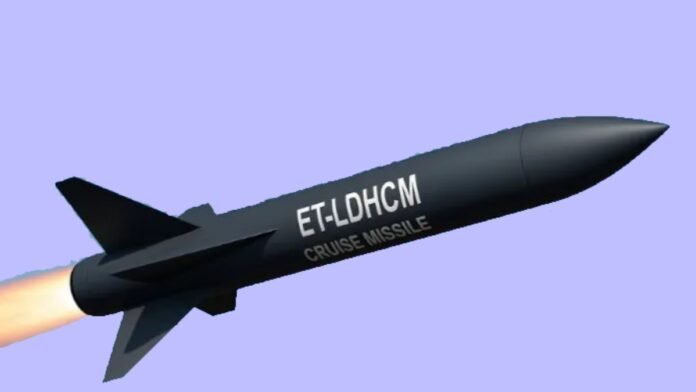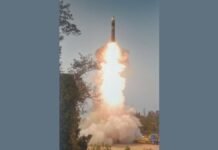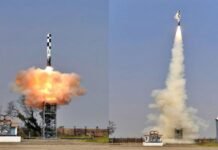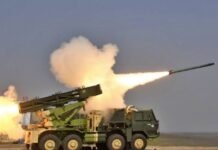
Key Points
- ET-LDHCM Hypersonic Cruise Missile, developed by DRDO under Project Vishnu, successfully test-fired on July 14, 2025.
- Flies at Mach 8 (~11,000 km/h), can hit targets up to 1,500 km away.
- Capable of carrying 1,000–2,000 kg conventional or nuclear warheads.
- Indigenous scramjet engine allows low-altitude, radar evading flight and mid-flight maneuvering.
- All three Indian armed forces can deploy it from land, sea, or air platforms.
- Gives India strategic coverage over all of Pakistan and deep into central China.
- Puts India among an elite group of nations US, Russia, and China with indigenous operational hypersonic capability.
New Delhi: In a historic breakthrough for defense technology, India’s Defence Research and Development Organisation (DRDO) has successfully tested the Extended Trajectory Long Duration Hypersonic Cruise Missile (ET-LDHCM) under Project Vishnu. With the ability to cover the entire territory of Pakistan and penetrate deep into Chinese strategic zones, this missile dramatically upgrades India’s military reach and deterrence in a rapidly shifting global defense landscape.
What is the ET-LDHCM Missile?
- ET-LDHCM (Extended Trajectory Long Duration Hypersonic Cruise Missile) is DRDO’s most advanced, fully indigenous hypersonic missile to date.
- Developed as part of Project Vishnu, a flagship initiative aimed at enhancing India’s missile arsenal with next-gen technology.
- Sets itself apart from earlier supersonic missiles like BrahMos, delivering much higher speeds, greater range, and enhanced survivability against modern air defenses.
Standout Features of ET-LDHCM
| Feature | Details |
|---|---|
| Speed | Mach 8 (approx. 11,000 km/h) |
| Range | 1,500 km (with some reports of future variants up to 2,000+ km) |
| Warhead Capacity | 1,000–2,000 kg, both conventional and nuclear |
| Propulsion | Advanced air-breathing scramjet engine utilizing atmospheric oxygen (no rotary compressor), enabling sustained hypersonic flight |
| Thermal Endurance | Materials and engine systems withstand ~2,000°C |
| Guidance & Maneuverability | Advanced inertial navigation with satellite correction (NavIC/GPS), highly maneuverable—can evade missile defense, alter trajectory mid-flight |
| Launch Platforms | Land-based, air, and sea deployment capability for all military branches |
| Stealth | Flies at low altitudes, reduces radar detection, can penetrate dense air defense networks |
Why Is ET-LDHCM a Strategic “Gamechanger”?
1. Speed and Range
At Mach 8, ET-LDHCM travels three kilometers every second, outpacing and outdistancing current and legacy systems like BrahMos, and making interception by enemy missile defenses nearly impossible.
2. Lethal Payload
It can deliver a massive punch with either conventional or nuclear warheads enabling devastating strikes against high-value or deeply entrenched targets.
3. Versatile Launch Capabilities
Land, air, and sea launch options make it deployable by the Army, Air Force, and Navy, providing India with supreme flexibility in planning and execution.
4. Evasion and Survivability
State-of-the-art guidance systems, low-altitude flight, and mid-flight trajectory correction allow the missile to evade detection and neutralization by current air defense shields like HQ-9P, HQ-16, or even S-400.
5. Indigenous Innovation
Engineered and manufactured entirely in India including its next-gen scramjet propulsion the ET-LDHCM underscores India’s technological leap and self-reliance in hypersonic weapons.
Target Coverage: Why Pakistan and China Are Within Reach
- Pakistan: With a total length (north-south) of about 1,600 km and width (east-west) of 650–700 km, the ET-LDHCM can strike anywhere inside Pakistan including all major military and civilian centers like Islamabad, Lahore, Karachi, and Rawalpindi.
- China: Even with China’s massive geography 5,200 km east-west, 5,500 km north-south launches from Ladakh or Arunachal Pradesh can easily threaten strategic Chinese military bases in Tibet, Xinjiang, or even deeper. The missile’s range gives India deterrence over sensitive targets in the region, including high-altitude or border zones.
The Technology Edge: How Is India Leading the Hypersonic Race?
- Only Russia, China, and the US possess operational hypersonic cruise missile capabilities: India now joins this exclusive club with a homebuilt system.
- Recent Milestones: A 1,000-second scramjet combustor ground test in April 2025 validated India’s expertise in sustained hypersonic propulsion a feat achieved by few nations.
- Strategic Posture: The ET-LDHCM, part of a broader suite of 12 hypersonic systems under Project Vishnu, positions India as a formidable power with advanced, next-gen missile deterrence for the next decade.
India’s successful test of the ET-LDHCM hypersonic cruise missile represents a defining leap in military technology and deterrence. Its unmatched speed, range, and dual-use capability (conventional and nuclear) empower India to cover its major adversaries Pakistan and China while denying them the comfort of missile defense. This formidable new weapon not only modernizes India’s deterrent but also signals its arrival among the world’s high-technology defense leaders.
[Note: All specifications and operational details are based on official sources and leading defense news coverage as of July 15, 2025.]




















































